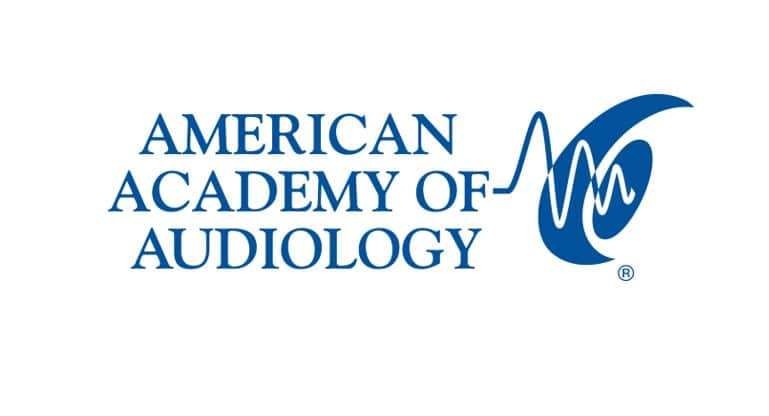RESTON, VIRGINIA — The American Academy of Audiology Foundation (AAAF) funds annually the American Academy of Audiology’s research program to support students in basic research in hearing and balance.
The Academy and the AAAF jointly support this program to award $5,000 each for the Student Investigator Research Grant and the Student Investigator Research Grant—Vestibular. The latter grant is partially funded through generous donations from Dr. Richard Gans and the American Institute of Balance. The AAAF and the Academy also support New Investigator Research Grants, the Music and Hearing Research Grant Program (open now for applications through July 29), and other special topic research grants.
The Academy congratulates Rhagav Jha of James Madison University and Emily Thompson of Vanderbilt University as the 2022 student investigator grant recipients. The grantees will work closely with a mentor over the year to complete the research study and submit a final report by September 2023. The Academy encourages the presentation of research findings at the annual conference, as well. An overview of the funded research projects follows.
Student Investigator Research Grant

Grant Recipient: Emily Catherine Thompson, AuD
Vanderbilt University
Department of Hearing and Speech Sciences
Mentor: Anne Marie Tharpe, PhD, Professor and Chair, Department of Hearing and Speech Sciences, Vanderbilt University
Title: Effects of Remote Microphone System Use in Home Environments of Preschool Children with Autism Spectrum Disorder (ASD)
Purpose of the Project: The purpose of this research study is to explore the effects of short-term remote microphone (RM) system use in home environments on auditory and communicative behaviors in a cohort of preschool-age children diagnosed with ASD and their caregivers. Potential real-world impacts of RM system use will be investigated across various dimensions, such as functional hearing, vocalization rate, dyadic child-caregiver language exchanges, and caregiver-reported perceptions of this technology.
Clinical Application of the Project: This study is designed to investigate the impact of remote microphone (RM) system use on communication between children with ASD and their caregivers. By providing this technology to families of these children to use in home settings, this project is well-positioned to determine if this intervention can improve caregiver-child interactions and/or focus children’s attention while communicating. These findings can have valuable implications for clinical practice by informing future recommendations for RM system use for those with ASD. Furthermore, outcomes of this research can inform public health agencies and educational organizations on the appropriateness of financial investments in this treatment option.
Aims: Extending our laboratory’s prior work in this area, the project aim is to explore the effects of short-term RM system use on auditory and communicative behaviors in home environments in a cohort of 20 children, ages 3 to 6 years, diagnosed with autism spectrum disorder (ASD). A within-subjects, repeated measures study design will examine various aspects of child-caregiver dyad communication, and subjective caregiver perceptions of their child’s auditory behavior when using and when not using an RM system at home during a device trial over two weekends. The specific aims and hypotheses are as follows:
- AIM 1: Evaluate caregivers’ use of repetitions/clarifying statements, and alerting phrases. Hypothesis 1: On average, when using an RM system, it is expected that caregivers will produce fewer verbal repetitions and alerting phrases per sample than without RM system use at home. This reduction in caregivers’ repetitions and alerting phrases might serve as an index of increased responsiveness by the children when using an RM system.
- AIM 2: Describe the effects of RM system use on child and caregiver dyad communication. Hypothesis 2a: Relative to no RM system use, RM system use is not expected to have a systematic impact on child vocalizations across participants. Some children might have aversive reactions to the enhanced SNR or presence of an ear-level worn device, while others might have heightened attention towards the speaker who is amplified, resulting in considerable vocalization variance across children in the short span of this study. Hypothesis 2b: Compared to no RM system use, RM system use is expected to yield a significant increase in caregivers’ number of vocalizations, on average. This increase might reflect children’s enhanced access to clear, direct speech via the RM system, thus prompting greater verbal engagement from caregivers. Hypothesis 2c: Contrasted with no RM system use, RM system use is expected to yield an increase in conversational turn counts, on average, across the participant group.
- AIM 3: Examine families’ subjective experiences with and qualitative perceptions of RM system use. Hypothesis 3: As a result of RM system use, caregivers will report listening improvements at home for their children with ASD, including enhanced responsiveness, coupled by greater ease of family communication.
Abstract: Children with autism spectrum disorder often exhibit deficits in performance on auditory-based tasks, especially in the presence of background noise. Speech perception-in-noise difficulties could detrimentally impact speech and language development, communication within family units, social relationships, and academic achievements. To address these potential consequences, current evidence suggests that wireless hearing technologies, such as remote microphone (RM) systems, facilitate listening in background noise.
Eligible participants will be recruited from Vanderbilt University Medical Center. Language Environmental Analysis (LENA™) recorders provide an innovative approach to capturing the vocalizations of 20 families in their homes during two consecutive weekends (RM system and no-RM system conditions). The following measurements will be collected and coded from the LENA recorders following both weekends: (1) total amount of child talk; (2) total amount of caregiver talk; (3) number of dyadic conversational turns between children and caregivers; and (4) number of caregiver-produced repetitions and alerting phrases during verbal interactions. In addition, caregivers’ perceptions of RM system use will be gathered via a self-report questionnaire. Findings from this study could serve to inform clinical recommendations for future management of children with autism spectrum disorder.
Student Investigator Research Grant – Vestibular

Grant Recipient: Raghav H Jha, PhD Candidate
James Madison University
Mentors: Erin G. Piker, AuD, PhD (Primary), Associate Professor and Director of the Vestibular Sciences Lab, Department of Communication Sciences and Disorders, James Madison University
Christopher G. Clinard, PhD (Co-Mentor), Associate Professor and Director of the Auditory Perception and Physiology Lab, Department of Communication Sciences and Disorders, James Madison University
Title: Age-Related Changes in the Sacculo-colic Reflex Pathway and Changes in the Nonlinearity of the Vestibular System
Purpose of the Project: The project will expand our understanding of age-related changes in the vestibular system that will lay a foundation in establishing newer diagnostic assessments to improve the standard of care for dizzy patients and older adults at risk for falling.
Clinical Applications of the Project: Nonlinearity in the vestibular system has been shown in animal models but there are currently no non-invasive methods for assessing this in humans. Further, we currently have limited information regarding steady state vestibular responses. In the auditory system, advantageous clinical information can be gleaned from steady state stimuli relative to transient (e.g. better frequency selectivity, accurate threshold estimation). The current proposal has the potential to tap sustained activity and nonlinear behavior of vestibular system which will open areas for further exploration and new assessment methods to improve the standard of care for dizzy patients.
Aims: The long-term goal is to understand changes in the vestibular system as an effect of aging and to improve the standard of care for older adults at risk for falling. The overall objective of this research is to examine sacculo-collic pathway functioning using amplitude modulated signal that will lay a foundation in establishing newer ways of assessing vestibular functioning. We plan to achieve our objectives by pursuing following aims.
- AIM 1: Determine the effect of age on the shape of AMcVEMP temporal modulation transfer function (TMTF). We plan to administer AMcVEMP on young, middle-age and older adults at 500 Hz carrier frequencies using 10 different modulation frequencies: 11, 17, 23, 37, 53, 79, 113, 173, 263, 397 Hz. It is expected that the older adults will have a narrower TMTF compared to young and middle-age adults for all the parameters used for assessment. We aim to compare the groups, for amplitude, signal-to-noise ratio, phase coherence of AMcVEMP across 10 modulation frequencies.
- AIM 2: Characterize non-linear properties in the human vestibular system as an effect of aging. To study non-linearity, we will be analyzing the amplitude, SNR and phase coherence from second through fourth harmonics of modulation frequency. We expect reduction in the presence of non-linearity among older adults compared to younger groups as seen in the auditory system.
Abstract: Although many advances have been made in the past 30 years, vestibular diagnostic assessments are still new and our ability to assess the vestibular system is limited compared to other sensory systems such as the auditory system. Further, due to the limited clinical utility of available vestibular diagnostic tests, 20%-30% of dizzy patients’ diagnoses remain unspecified. The current proposal will elicit cervical vestibular evoked myogenic potentials (cVEMP) using amplitude modulated signals (AMcVEMP), a method that has the potential to tap mechanisms such as sustained activity and nonlinearity of vestibular system that cannot be explored using conventional (i.e. transient or tone-burst evoked cVEMP) assessment procedures. The pilot data show the feasibility of this technique in young , healthy adults and alludes to degrading changes in the sustained activity and nonlinear behavior of vestibular system among older adults, substantiating the need for detailed investigation on a larger sample size. In the current proposal, AMcVEMP analyses will be fast Fourier transform (FFT) based looking for responses at the modulation frequencies and at its harmonics, as measures of vestibular nonlinearity, across the life span.
Source: AAA







